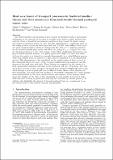Por favor, use este identificador para citar o enlazar a este item:
http://hdl.handle.net/10261/140673COMPARTIR / EXPORTAR:
 SHARE SHARE
 CORE
BASE CORE
BASE
|
|
| Visualizar otros formatos: MARC | Dublin Core | RDF | ORE | MODS | METS | DIDL | DATACITE | |

| Campo DC | Valor | Lengua/Idioma |
|---|---|---|
| dc.contributor.author | Klepikova, Maria V. | es_ES |
| dc.contributor.author | Le Borgne, Tanguy | es_ES |
| dc.contributor.author | Bour, Olivier | es_ES |
| dc.contributor.author | Dentz, Marco | es_ES |
| dc.contributor.author | Hochreutener, Rebecca | es_ES |
| dc.contributor.author | Lavenant, Nicolas | es_ES |
| dc.date.accessioned | 2016-11-24T07:33:28Z | - |
| dc.date.available | 2016-11-24T07:33:28Z | - |
| dc.date.issued | 2016-07-01 | - |
| dc.identifier.citation | Water Resources Research 52(7): 5442-5457 (2016) | es_ES |
| dc.identifier.uri | http://hdl.handle.net/10261/140673 | - |
| dc.description.abstract | The characterization and modeling of heat transfer in fractured media is particularly challenging as the existence of fractures at multiple scales induces highly localized flow patterns. From a theoretical and numerical analysis of heat transfer in simple conceptual models of fractured media, we show that flow channeling has a significant effect on the scaling of heat recovery in both space and time. The late time tailing of heat recovery under channeled flow is shown to diverge from the (Formula presented.) behavior expected for the classical parallel plate model and follow the scaling (Formula presented.) for a simple channel modeled as a tube. This scaling, which differs significantly from known scalings in mobile-immobile systems, is of purely geometrical origin: late time heat transfer from the matrix to a channel corresponds dimensionally to a radial diffusion process, while heat transfer from the matrix to a plate may be considered as a one-dimensional process. This phenomenon is also manifested on the spatial scaling of heat recovery as flow channeling affects the decay of the thermal breakthrough peak amplitude and the increase of the peak time with scale. These findings are supported by the results of a field experimental campaign performed on the fractured rock site of Ploemeur. The scaling of heat recovery in time and space, measured from thermal breakthrough curves measured through a series of push-pull tests at different scales, shows a clear signature of flow channeling. The whole data set can thus be successfully represented by a multichannel model parametrized by the mean channel density and aperture. These findings, which bring new insights on the effect of flow channeling on heat transfer in fractured rocks, show how heat recovery in geothermal tests may be controlled by fracture geometry. In addition, this highlights the interest of thermal push-pull tests as a complement to solute tracers tests to infer fracture aperture and geometry. © 2016. American Geophysical Union. All Rights Reserved. | es_ES |
| dc.description.sponsorship | The fieldwork data in this study is available from the authors upon request (maria.klepikova@erdw.ethz.ch). This work was supported by the European Marie Curie network IMVUL (grant agreement 212298), by the National Research Observatory H+ and by the European Interreg IV project CLIMAWAT and the ANR project Stock en socles. We also thank Alain Dassargues and Serge Brouyeres from the University of Liege, Belgium for their kind assistance in providing a water heater. MD acknowledges the support of the European Research Council (ERC) through the project MHetScale (617511). | es_ES |
| dc.language.iso | eng | es_ES |
| dc.publisher | American Geophysical Union | es_ES |
| dc.relation | info:eu-repo/grantAgreement/EC/FP7/617511 | es_ES |
| dc.relation.isversionof | Postprint | es_ES |
| dc.rights | openAccess | en_EN |
| dc.subject | Anomalous transport | es_ES |
| dc.subject | Fractured media | es_ES |
| dc.subject | Thermal tracer test | es_ES |
| dc.subject | Upscaling | es_ES |
| dc.title | Heat as a tracer for understanding transport processes in fractured media: Theory and field assessment from multiscale thermal push-pull tracer tests | es_ES |
| dc.type | artículo | es_ES |
| dc.identifier.doi | 10.1002/2016WR018789 | - |
| dc.description.peerreviewed | Peer reviewed | es_ES |
| dc.relation.publisherversion | 10.1002/2016WR018789 | es_ES |
| dc.embargo.terms | 2017-01-01 | es_ES |
| dc.contributor.funder | European Research Council | es_ES |
| dc.relation.csic | Sí | es_ES |
| oprm.item.hasRevision | no ko 0 false | * |
| dc.identifier.funder | http://dx.doi.org/10.13039/501100000781 | es_ES |
| dc.type.coar | http://purl.org/coar/resource_type/c_6501 | es_ES |
| item.grantfulltext | open | - |
| item.cerifentitytype | Publications | - |
| item.openairecristype | http://purl.org/coar/resource_type/c_18cf | - |
| item.languageiso639-1 | en | - |
| item.fulltext | With Fulltext | - |
| item.openairetype | artículo | - |
| Aparece en las colecciones: | (IDAEA) Artículos | |
Ficheros en este ítem:
| Fichero | Descripción | Tamaño | Formato | |
|---|---|---|---|---|
| klepikovwrr2016_postprint.pdf | 862,49 kB | Adobe PDF |  Visualizar/Abrir |
CORE Recommender
SCOPUSTM
Citations
52
checked on 09-abr-2024
WEB OF SCIENCETM
Citations
48
checked on 24-feb-2024
Page view(s)
251
checked on 16-abr-2024
Download(s)
281
checked on 16-abr-2024
Google ScholarTM
Check
Altmetric
Altmetric
NOTA: Los ítems de Digital.CSIC están protegidos por copyright, con todos los derechos reservados, a menos que se indique lo contrario.
